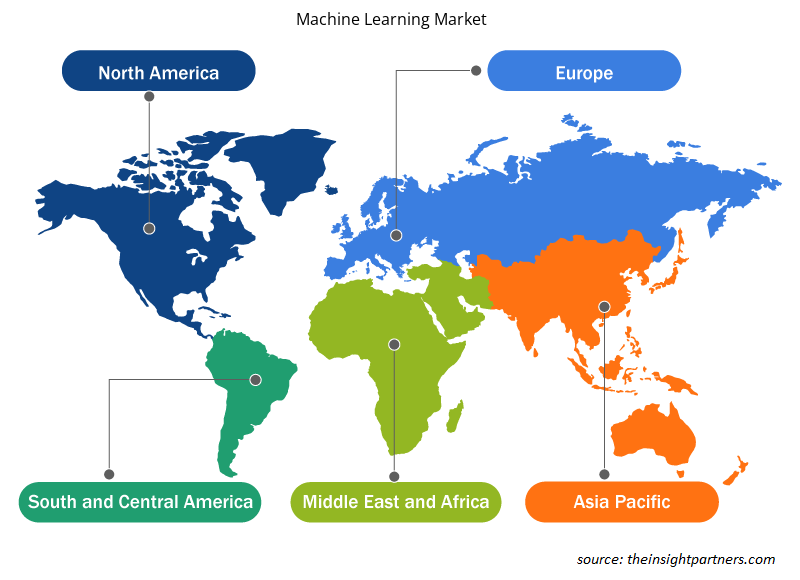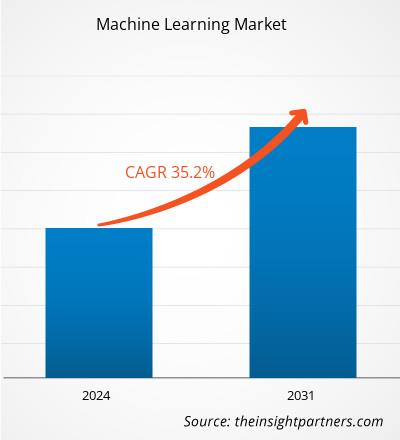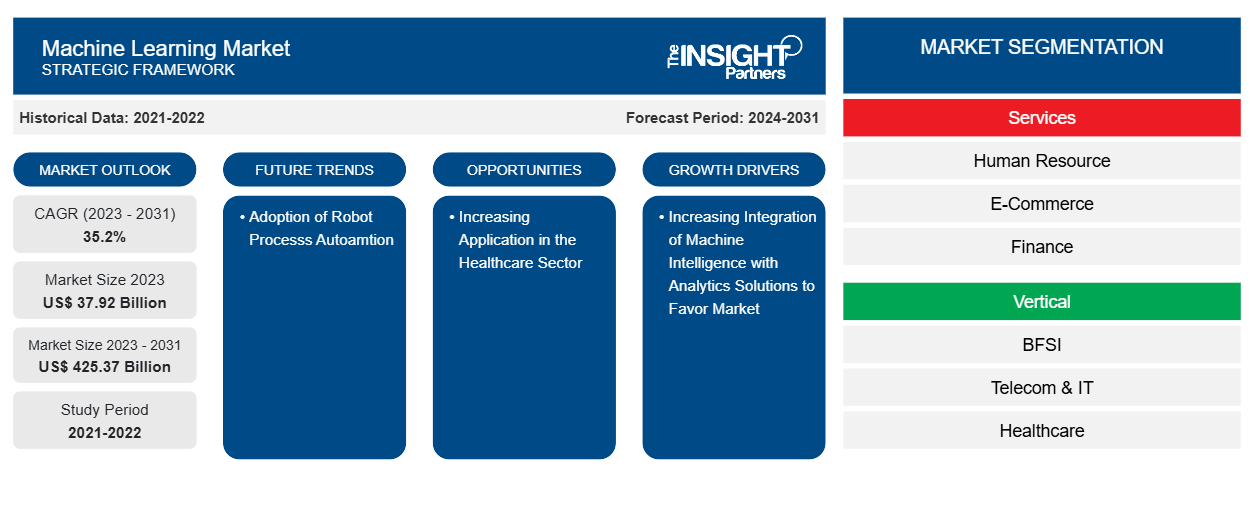Le marché de l'apprentissage automatique devrait atteindre 425,37 milliards de dollars d'ici 2031, contre 37,92 milliards de dollars en 2023. Le marché devrait enregistrer un TCAC de 35,2 % entre 2023 et 2031. L'intégration croissante de l'intelligence artificielle et l'augmentation des applications dans le secteur de la santé devraient rester les principales tendances du marché de l'apprentissage automatique.
Analyse du marché de l'apprentissage automatique
Le sous-domaine de l'informatique et de l'intelligence artificielle est connu sous le nom d'apprentissage automatique. Pour augmenter la précision, il se concentre sur les données et les algorithmes. La technologie qui permet à un ordinateur d'apprendre à partir de données historiques est appelée apprentissage automatique. Les algorithmes utilisés dans l'apprentissage automatique utilisent une variété de techniques pour extraire des connaissances à partir de données historiques. La quantité et les données historiques sont directement liées à l'exactitude des informations ou des données, et cette relation contribue au développement d'un modèle plus précis qui prévoit les données futures.
Aperçu du marché de l'apprentissage automatique
En raison de ses avancées technologiques, l'apprentissage automatique est une technologie émergente qui se développe chaque jour. De grands volumes de données sont traités à l'aide de l'apprentissage automatique en fonction des besoins organisationnels. Les humains ne sont pas en mesure de gérer l'énorme quantité de données ; par conséquent, des systèmes informatiques sont nécessaires pour l'analyse et la gestion des données . L'apprentissage automatique est l'un de ces outils. Le besoin de solutions technologiques pour gérer des données et des opérations complexes au sein des entreprises devrait propulser le marché de l'apprentissage automatique.
Personnalisez ce rapport en fonction de vos besoins
Vous bénéficierez d'une personnalisation gratuite de n'importe quel rapport, y compris de certaines parties de ce rapport, d'une analyse au niveau des pays, d'un pack de données Excel, ainsi que de superbes offres et réductions pour les start-ups et les universités.
-
Obtenez les principales tendances clés du marché de ce rapport.Cet échantillon GRATUIT comprendra une analyse de données, allant des tendances du marché aux estimations et prévisions.
Moteurs et opportunités du marché de l'apprentissage automatique
Intégration croissante de l'intelligence artificielle avec les solutions d'analyse pour favoriser le marché
La discipline de l'analyse du commerce de détail a connu une croissance significative au cours des dernières années. En utilisant des outils d'analyse de données de pointe, de nombreuses entreprises de commerce électronique, dont Alibaba, eBay et Amazon, ont augmenté leurs revenus et amélioré la satisfaction de leurs clients. La recherche et le développement dans le domaine de la technologie de reconnaissance vocale ont conduit à l'émergence de techniques de codage cognitif de la parole basées sur le machine learning.
L'augmentation des applications dans le secteur de la santé favorise le marché
De nombreuses applications dans le secteur de la santé utilisent déjà la technologie ML. Cette plateforme évalue des millions de points de données uniques dans ce secteur industriel, prévoit les résultats et offre une allocation précise des ressources et des scores de risque rapides.
Le diagnostic et l’identification de maladies parfois difficiles à diagnostiquer sont l’une des utilisations les plus importantes de cette technologie dans le secteur de la santé. Il peut s’agir de plusieurs maladies héréditaires et de cancers difficiles à identifier à un stade précoce. IBM Watson Genomics en est un exemple bien connu, démontrant comment le séquençage tumoral basé sur le génome, associé à l’informatique cognitive, peut aider à la détection du cancer.
Analyse de segmentation du rapport sur le marché de l'apprentissage automatique
Les segments clés qui ont contribué à l’élaboration de l’analyse du marché de l’apprentissage automatique sont les services et les secteurs verticaux.
- En fonction des services, le marché de l'apprentissage automatique est divisé en ressources humaines, commerce électronique, finances et comptabilité, service client, ventes et marketing, etc. Le segment des ressources humaines devrait croître au cours de la période de prévision.
- Le marché est segmenté en BFSI, télécommunications et informatique, santé, automobile, fabrication, alimentation et boissons, électricité et énergie, électronique grand public et autres. Le segment BFSI devrait croître au cours de la période de prévision.BFSI, telecom & IT, healthcare, automotive, manufacturing, food and beverage, power & energy, consumer electronics, and others. The BFSI segment is anticipated to grow in the forecast period.
Analyse des parts de marché de l'apprentissage automatique par zone géographique
La portée géographique du rapport sur le marché de l'apprentissage automatique est principalement divisée en cinq régions : Amérique du Nord, Asie-Pacifique, Europe, Moyen-Orient et Afrique, et Amérique du Sud/Amérique du Sud et centrale. L'Amérique du Nord a dominé le marché de l'apprentissage automatique. Les tendances d'adoption de haute technologie dans diverses industries de la région nord-américaine ont alimenté la croissance du marché de l'apprentissage automatique. Des facteurs tels que l'adoption accrue de la numérisation et les dépenses technologiques élevées des agences gouvernementales devraient stimuler la croissance du marché nord-américain de l'apprentissage automatique. De plus, l'accent mis sur la recherche et le développement dans les économies développées des États-Unis et du Canada oblige les acteurs nord-américains à apporter des solutions technologiquement avancées sur le marché. En outre, les États-Unis comptent de nombreux acteurs du marché de l'apprentissage automatique qui se concentrent de plus en plus sur le développement de solutions innovantes. Tous ces facteurs contribuent à la croissance du marché de l'apprentissage automatique dans la région.
Aperçu régional du marché de l'apprentissage automatique
Les tendances et facteurs régionaux influençant le marché de l’apprentissage automatique tout au long de la période de prévision ont été expliqués en détail par les analystes d’Insight Partners. Cette section traite également des segments et de la géographie du marché de l’apprentissage automatique en Amérique du Nord, en Europe, en Asie-Pacifique, au Moyen-Orient et en Afrique, ainsi qu’en Amérique du Sud et en Amérique centrale.

- Obtenez les données régionales spécifiques au marché de l'apprentissage automatique
Portée du rapport sur le marché de l'apprentissage automatique
| Attribut de rapport | Détails |
|---|---|
| Taille du marché en 2023 | 37,92 milliards de dollars américains |
| Taille du marché d'ici 2031 | 425,37 milliards de dollars américains |
| Taux de croissance annuel composé mondial (2023-2031) | 35,2% |
| Données historiques | 2021-2022 |
| Période de prévision | 2024-2031 |
| Segments couverts |
Par services
|
| Régions et pays couverts |
Amérique du Nord
|
| Leaders du marché et profils d'entreprises clés |
|
Densité des acteurs du marché de l'apprentissage automatique : comprendre son impact sur la dynamique des entreprises
Le marché de l'apprentissage automatique connaît une croissance rapide, tirée par la demande croissante des utilisateurs finaux en raison de facteurs tels que l'évolution des préférences des consommateurs, les avancées technologiques et une plus grande sensibilisation aux avantages du produit. À mesure que la demande augmente, les entreprises élargissent leurs offres, innovent pour répondre aux besoins des consommateurs et capitalisent sur les tendances émergentes, ce qui alimente davantage la croissance du marché.
La densité des acteurs du marché fait référence à la répartition des entreprises ou des sociétés opérant sur un marché ou un secteur particulier. Elle indique le nombre de concurrents (acteurs du marché) présents sur un marché donné par rapport à sa taille ou à sa valeur marchande totale.
Les principales entreprises opérant sur le marché de l'apprentissage automatique sont :
- Amazon Web Services, Inc.
- FICO
- Hewlett Packard Enterprise Development LP
- IBM
- Microsoft
Avis de non-responsabilité : les sociétés répertoriées ci-dessus ne sont pas classées dans un ordre particulier.

- Obtenez un aperçu des principaux acteurs du marché de l'apprentissage automatique
Actualités et développements récents du marché de l'apprentissage automatique
Le marché de l'apprentissage automatique est évalué en collectant des données qualitatives et quantitatives après des recherches primaires et secondaires, qui comprennent des publications d'entreprise importantes, des données d'association et des bases de données. Voici une liste des évolutions du marché :
- En février 2024, XTX Markets, l'une des principales sociétés de trading algorithmique, est ravie d'annoncer le lancement de XTY Labs, une nouvelle division d'apprentissage automatique qui sera dirigée par le nouveau directeur de recherche, le Dr Atlas Wang.
(Source : XTX Markets, Communiqué de presse, 2024)
- En avril 2024, AdTheorent Holding Company, Inc., l'un des pionniers de l'apprentissage automatique utilisant des solutions axées sur la confidentialité pour offrir une valeur mesurable aux annonceurs programmatiques, et Miles Partnership, une société de marketing stratégique axée exclusivement sur les voyages et le tourisme, ont annoncé les résultats de la campagne de publicité numérique VISIT FLORIDA Sun Seekers.
(Source : AdTheorent Holding Company, Inc, communiqué de presse, 2022)
Rapport sur le marché de l'apprentissage automatique et livrables
Le rapport « Taille et prévisions du marché de l'apprentissage automatique (2021-2031) » fournit une analyse détaillée du marché couvrant les domaines ci-dessous :
- Taille du marché et prévisions aux niveaux mondial, régional et national pour tous les segments de marché clés couverts par le périmètre.
- Dynamique du marché, comme les facteurs moteurs, les contraintes et les opportunités clés
- Principales tendances futures
- Analyse détaillée des cinq forces de PEST/Porter et SWOT
- Analyse du marché mondial et régional couvrant les principales tendances du marché, les principaux acteurs, les réglementations et les développements récents du marché.
- Analyse du paysage industriel et de la concurrence couvrant la concentration du marché, l'analyse de la carte thermique, les principaux acteurs et les développements récents.
- Profils d'entreprise détaillés
- Analyse historique (2 ans), année de base, prévision (7 ans) avec TCAC
- Analyse PEST et SWOT
- Taille du marché Valeur / Volume - Mondial, Régional, Pays
- Industrie et paysage concurrentiel
- Ensemble de données Excel
Rapports récents
Rapports connexes
Témoignages
Raison d'acheter
- Prise de décision éclairée
- Compréhension de la dynamique du marché
- Analyse concurrentielle
- Connaissances clients
- Prévisions de marché
- Atténuation des risques
- Planification stratégique
- Justification des investissements
- Identification des marchés émergents
- Amélioration des stratégies marketing
- Amélioration de l'efficacité opérationnelle
- Alignement sur les tendances réglementaires























 Obtenez un échantillon gratuit pour - Marché de l'apprentissage automatique
Obtenez un échantillon gratuit pour - Marché de l'apprentissage automatique